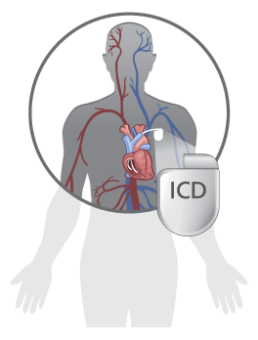A decision aid for patients considering ICD therapy for primary prevention.
This site is for patients with heart failure considering an ICD who are at risk for sudden cardiac death (primary prevention). This website will lead you step-by-step through some information on ICDs that may be helpful. We also hope this will make talking to your doctor easier.
What is an Implantable Cardioverter Defibrillator (ICD)?
An ICD is a small device that is placed under the skin of the chest. Wires (called “leads”) connect the ICD to the heart. An ICD is designed to prevent an at-risk person from dying suddenly from a dangerous heart rhythm. When it senses a dangerous heart rhythm, an ICD gives the heart an electrical shock. It does this in order to get the heart to beat normally.

Frequently Asked Questions
Due to your heart failure, you are at higher risk for developing a dangerous heart rhythm. A dangerous heart rhythm can cause you to die within minutes if not treated.
Heart failure is when a heart is too weak to pump enough blood for the body. People with heart failure sometimes have breathing problems, leg swelling, and feel tired. Some people with heart failure may have no symptoms.
It is best not to remove the ICD unless you have an infection or are having the ICD replaced.
Yes. The ICD is put under the skin and one or more wires (called “leads”) are put into the heart. The surgery takes a few hours. You may stay in the hospital overnight.
Yes, it is possible to turn off the ICD without surgery. This is even recommended when a person is close to dying of another cause.
In the future, people may reach a point where living as long as possible is not what they want anymore. This could be because of worsening heart failure or another illness. When this happens the ICD can be turned off to avoid shocks.
Supporting Evidence
Here is a document outlining all evidence for practice decision aids, to help you in your decision.
